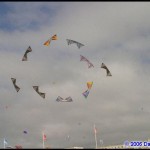 Apparently, my trip to France in April still hasn’t really left my brain yet. When John and I returned, by the next festival in the Northwest, we were flying as multiline pairs (“Felonious Monk” obviously, I’m the monk-ey…) and we’d started pondering how to put together our own rev team, which came to be called iQuad, made up of myself, John Barresi, Egan Davis and Todd Rudolph, as well as JD Fabich and Justin Redington (alternate fliers). This is a much cheaper approach to rev team flying than jetting over to Europe all the time and its proving to be a lot of fun, more and more everytime we have a go of it.
Apparently, my trip to France in April still hasn’t really left my brain yet. When John and I returned, by the next festival in the Northwest, we were flying as multiline pairs (“Felonious Monk” obviously, I’m the monk-ey…) and we’d started pondering how to put together our own rev team, which came to be called iQuad, made up of myself, John Barresi, Egan Davis and Todd Rudolph, as well as JD Fabich and Justin Redington (alternate fliers). This is a much cheaper approach to rev team flying than jetting over to Europe all the time and its proving to be a lot of fun, more and more everytime we have a go of it.
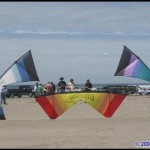 That being said, in order for either multiline pairs or team to become a recognized AKA competition discipline, it will require more people to
That being said, in order for either multiline pairs or team to become a recognized AKA competition discipline, it will require more people to 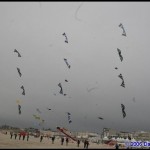 participate, hence the idea here is to promote the idea and provide some ideas and basics in order to stimulate further interest in this. It’s the ultimate challenge in quad flying; have no doubt about that at all. Its very much one thing to solo around the sky and quite another to move in conjunction with others but, the end result is worth it. Trust us, the crowd reaction to choreographed groups of quads is very strong.
participate, hence the idea here is to promote the idea and provide some ideas and basics in order to stimulate further interest in this. It’s the ultimate challenge in quad flying; have no doubt about that at all. Its very much one thing to solo around the sky and quite another to move in conjunction with others but, the end result is worth it. Trust us, the crowd reaction to choreographed groups of quads is very strong.
In addition to being part of a great show, most fliers will find that their skills improve significantly in a very short period of flying team… I speak from experience, having experienced the mega-teams of Europe, it definitely helps you learn.
WSIKF/AKA Grand Nationals
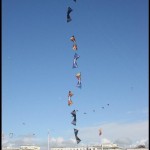 John and I spent the entire week at WSIKF last summer, and the fun we had made sure that we planned to do the same again this summer, but, as spring came around and we got immersed in Rev team flying, we developed a focus for WSIKF. We’re going to take over a chunk of beach right beside Revolution’s usual training area (where I have spent many a day helping introduce people to Revs!) and fly team. All week. With just about anyone who a] wants to and b] has a few basics under their belt. Seven days, from the start of the day till whenever it gets dark, or we run out of energy…(not very likely). I’ll be organizing a similar event at the AKA Grand Nationals, titled as “Quadpalooza”, where any quad is invited, but we’ll also try and have some team specific activities as well. I think all of iQuad will be in attendance, plus, the cream of North America’s quad flyers.
John and I spent the entire week at WSIKF last summer, and the fun we had made sure that we planned to do the same again this summer, but, as spring came around and we got immersed in Rev team flying, we developed a focus for WSIKF. We’re going to take over a chunk of beach right beside Revolution’s usual training area (where I have spent many a day helping introduce people to Revs!) and fly team. All week. With just about anyone who a] wants to and b] has a few basics under their belt. Seven days, from the start of the day till whenever it gets dark, or we run out of energy…(not very likely). I’ll be organizing a similar event at the AKA Grand Nationals, titled as “Quadpalooza”, where any quad is invited, but we’ll also try and have some team specific activities as well. I think all of iQuad will be in attendance, plus, the cream of North America’s quad flyers.
Equipment:
Kites…
While you can perform this type of flying with any quad line, it looks best when all of the kites used are of the same model. It also ensures that all kites can move in a very similar style in the given wind. So, much as everyone in Europe has done with team rev flying lately, we’re sticking with the Revolution 1.5 for team play, either in a standard sail, or vented versions. The advantage to this is also that most people who own a rev, own a 1.5. Handle wise, it’s entirely your own choice, though most of us seem to be stuck on the original SUL handles. Ideally, you’ll have a frame for any wind; however, as this takes a lot of rods, I wouldn’t worry about it too much.
Line Lengths…
Ah, this is the part that’s always proved the trickiest over here, but it’s very advisable. Before John and I flew over in April, we checked around and found every single one of the European quad teams used 120 foot lines. These work well for as couple of reasons. First, the extra length slows down the kites a little. You are aiming for nice, timed, slowish moves through the sky. And with four revs in the sky, they take up a little room so the additional length helps to fill the sky and give all the kites a larger area to move in, so if all 4 are laddering up, you won’t run out of sky two rotations up. Extend lines if you have to, but, please show up with a set that’s 120 feet in length. We’ve tried this with people at 100 and 110 feet in with the 120 and it simply becomes dangerous with the lines crossing over against the shorter kites. So, humor us 😉
Moves:
The Basics…
The most basic of “moves” required for Rev team play is deceptive in it’s apparently simplicity but, once you get to actually doing it, it can prove to be a challenge for people. That’s simply having the ability to hold the kite in any position, in any place in the sky, for extended periods of time. Not like 30 minutes of extended time, however, be prepared to hang upside in any position for 15 seconds as a general rule.
“Follow” is the easiest of the “standard” array of team moves, you simply follow behind the leader, keeping an equal spacing and speed the entire time. We’ll often warm up with this, just to get everyone’s brain into the proper gear for more delicate work. You’ll find that for corners, you’ll have a tendency to carve these out more than a sharp 90 degree corner.
One note, many of the terms we’re using originated with the European quad teams, so credit where credit is due and a large thanks for their direction and trailblazing with this goes out to The Decorators (the true originators) , The Flying Squad, Team 4 Fun and FLIC (and other we have yet to cross paths with so far).
Sometimes, to spice it up a little, we’ll call for Pez, where the lead kite will come down in a vertical slide, with the others following along in line with the first turn. We’ll usually slide across the bottom upside down as well once into this positioning. Extra sexiness points for also sliding vertically back up!
Ball… (click for Flash animation)
A ball with the entire team (3 or more), is simply known as “ball or “Big ball”… Be aware that to American ears, some European teams may also sound as if they are saying “big bowl” due to accents.
The outside kites on a line drop down, closing the line while the other kites change position to follow the “C” shape as it closes into an “O”, then stop in place.
Coming back into the line, simply reverse the motion you used to make the ball.
Switch Place… (click for Flash animation)
Team 4 Fun referred to this as Dice (in English at least ;-)) and it’s pretty straightforward. Just pick an alignment that works with the number of kites you have, i.e., a triangle for 3, a square for 4, and swap positions on a Go command. For example in a triangle, with a kite up top and two spaced out on the bottom, a clockwise Go will see the top kite move to the bottom right corner, the bottom right corner slides to the left bottom position and the left bottom will move to the top. One thing to bear in mind, any move like this involving rotation, the caller will specify clockwise or counterclockwise/anticlockwise (anti for short). This also applies with the pinwheel and radar moves.
Pinwheel & Radar… (click for Flash animation)
Here’s a pair of circle moves that we tend to use regularly, the Pinwheel and Radar. Both usually start from a line, and rotate through 45 – 360 degrees, either with stops at specific points, or as one single movement. There’s a difference between the two, a Pinwheel will rotate around the center of the line of kites, and a radar will rotate around one of the end kites. The flash files I generated display this better than I can explain in text, however bear in mind there is endless variations of this, for example in a Pinwheel, take the left two kites and hover them upside before you start. Or, place kites at 0, 90, 180, 270 degrees and start from there. Particularly impressive is a full 360 sweep of radar but, its tough to maintain speed and positioning control for that length. Consider it a challenge, I loved watching The Flying Squad do this!
(A caveat on the flash files… Initially, I’d seen Team 4 Fun’s website, which includes some Macromedia Flash generated files of their routines, and John and I decided to take a crash course in Flash as it looks like a great way to choreograph flight patterns. That being said, excuse my work on these, it’s pretty rudimentary and rough in spots. We’ll publish more polished ones here and at iquad.us once we get some more time to tweak)
With Benefits… (click for Flash animation)
The name for this move is shamelessly stolen from The Flying Squad in England…To start this, lineup all the kites vertically, with alternating leading edges facing outwards. The top kite is the one that does the most work as it works its way up and down through the line. The top 2 kites will move first, basically swapping positions by flying a half circle either down or up. Next, the middle two (which is now kite #1 from the top) swap positions in the same fashion and lastly, the bottom two (which again, includes kite #1) swap.
After this, a quick 180 degree in place by everyone lines you up to move back up through the line with the bottom two swapping, followed by the middle two and the top two. After that, you are done! Variations on this include the FLIC variant when the top and bottoms swap while the middle two do the same, but, this is tough to time properly as the middle two have to move as “quickly/slowly” as the outer two kites. At first, this is really tough move as the pressure on your lines grows as the top kites works its way down, but, you do get used to it, simply focus on your own kite at all times.
“Groups of” call for the whole team to work in smaller groups. In the Ball example below, you see a team of four kites… If there were six, a group call would be something like:
“Groups of 3, collpase to ball!”
With this call, the left three and right three would make two seperate balls side by side… In each group, one kite is on top (facing up) and two kites are on the bottom (each facing the lower corner of the window).
A burst from this scenario would send the the lower inside kites right up to each other, at which point they stop right where they meet in the middle of the window, just above the ground. Naturally, group ball maneuvers are a little smaller on the burst than with the entire team in one big ball.
Just a few of the possible variants, for example:
- Team of 8, “two groups of four”.
- Team of 9, “three groups of three”.
- Team of 10, “two groups of five”.
- Team of 12, “three groups of four”, “four groups of 3” or “two groups of 6”.
Obviously, it helps to have a certain number of fliers to work in groups otherwise you may have an odd kite in the equation.
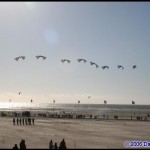 So there, a few helpful starters for developing your own quad pair or team effort. Find a person or more of a similar skill level to yourself and start playing around. I’m firmly convinced by this point that there is a tremendous amount of potential yet to be exploited with this kind of flying, and as more people become involved, the quicker it will evolve and perhaps someday, we’ll be doing this as an event at the AKA Grand Nationals. Or perhaps a World Championships for Revolution’s 20th anniversary, maybe somewhere exotic with piles of wind, sun and sand and fancy drinks with umbrellas in them?
So there, a few helpful starters for developing your own quad pair or team effort. Find a person or more of a similar skill level to yourself and start playing around. I’m firmly convinced by this point that there is a tremendous amount of potential yet to be exploited with this kind of flying, and as more people become involved, the quicker it will evolve and perhaps someday, we’ll be doing this as an event at the AKA Grand Nationals. Or perhaps a World Championships for Revolution’s 20th anniversary, maybe somewhere exotic with piles of wind, sun and sand and fancy drinks with umbrellas in them?
Be sure to come out and visit and fly with us this August 21 – 27th, at WSIKF in Long Beach, Washington, and also on Thursday, October 5th at the AKA Grand Nationals, in Des Moines, Iowa.
Start a quad pair in your own conference and start asking for it to be placed onto competition events, even thought there are no AKA points.
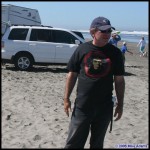 There are compulsory figures already in place, and rules within the IRBC, it’s just waiting for us to ask for its inclusion and development by demonstrating not only an interest from the fliers by way of new teams, but also the amazing audience response that quad teams bring out anywhere they fly.
There are compulsory figures already in place, and rules within the IRBC, it’s just waiting for us to ask for its inclusion and development by demonstrating not only an interest from the fliers by way of new teams, but also the amazing audience response that quad teams bring out anywhere they fly.
Best of winds to all of you,
David Hathaway

